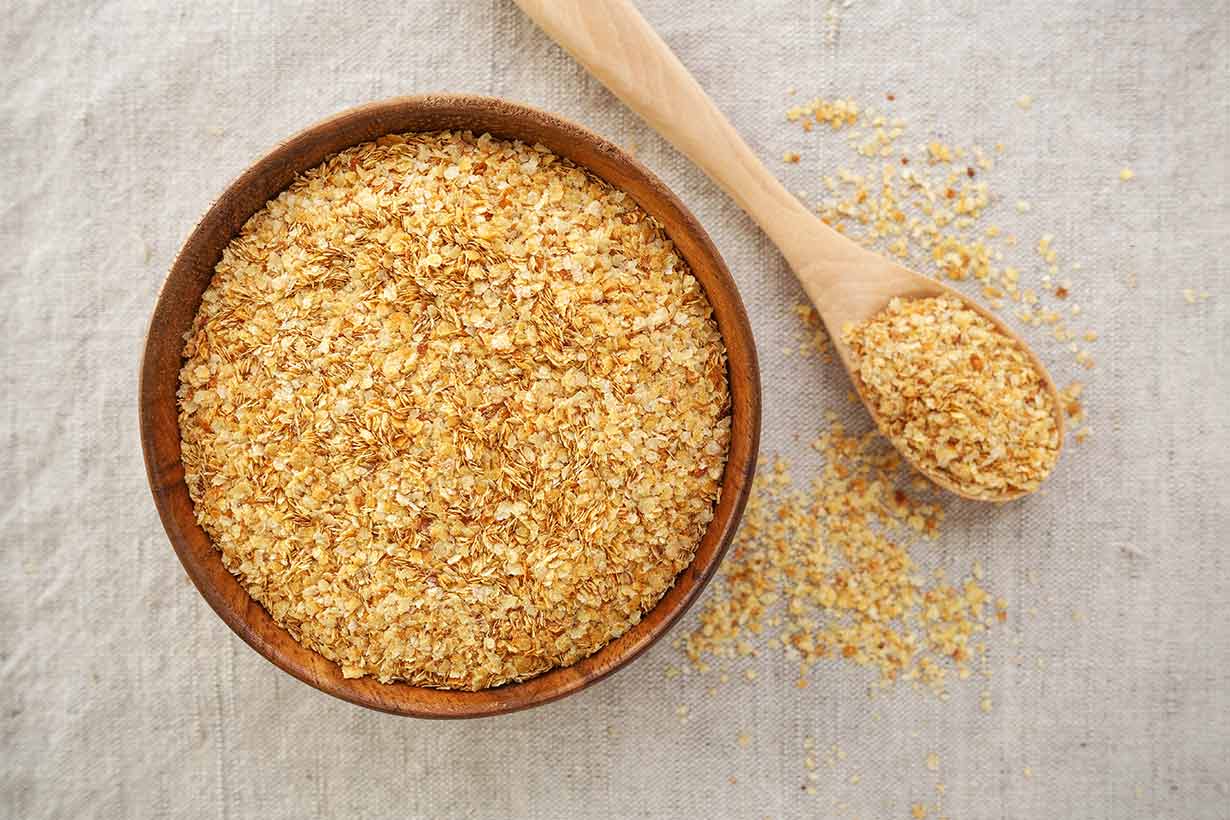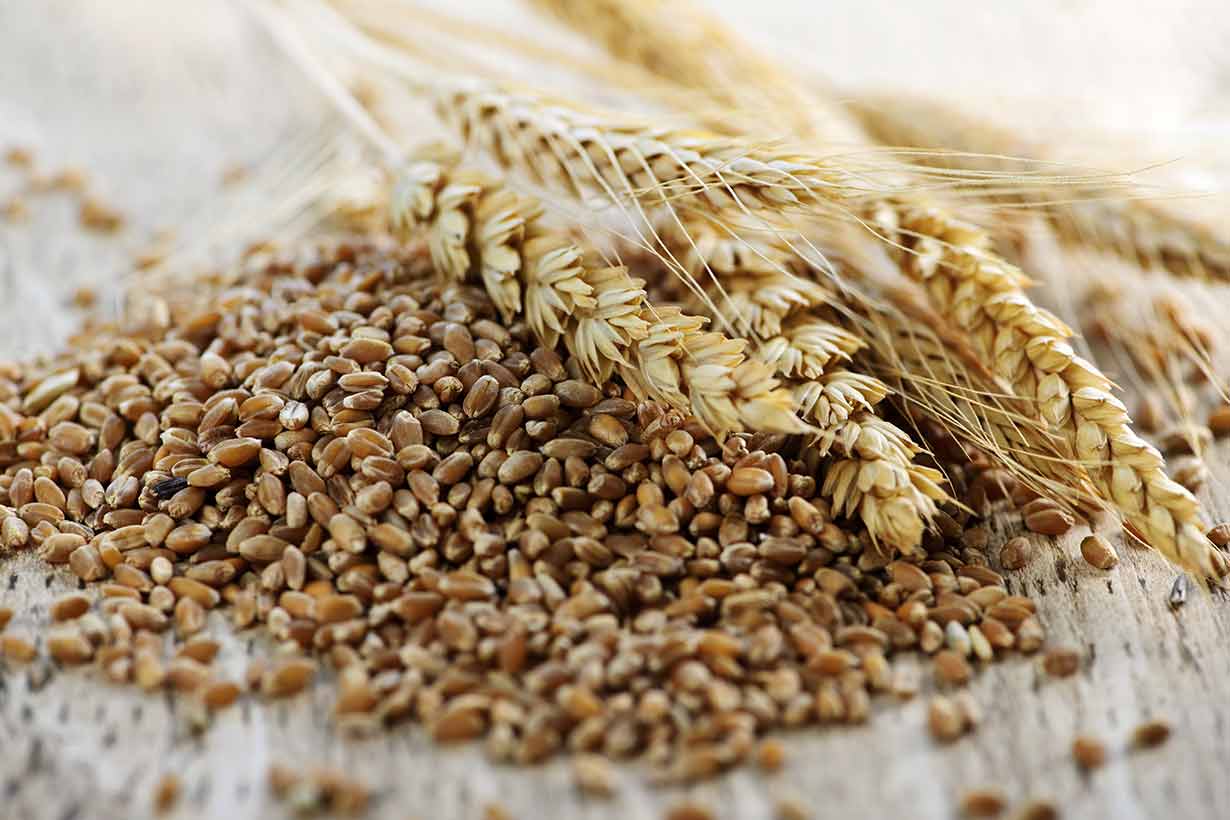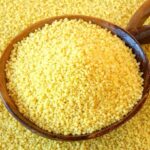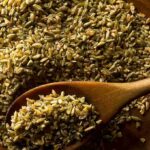Wheat is one of the most popular crops globally, but not all parts of the wheat plant are the same nutritionally.
The germ (known as wheat germ) is one of the more nutritious parts of wheat. It is an excellent source of fiber and numerous essential vitamins and minerals.
This article examines the nutritional properties of wheat germ, its potential benefits, and how to use it.
What Is Wheat Germ?

Firstly, wheat berries (whole wheat kernels) are a true whole grain food containing wheat’s bran, germ, and endosperm.
Here is a simple breakdown of how these parts of the wheat plant differ (1):
- Wheat bran is the fibrous outer coating of the wheat kernel, and it contains fiber, B vitamins, and minerals.
- Wheat germ contains various nutrients, including fiber, vitamins, minerals, proteins, and fats. The germ is the part of the plant that provides all the necessary nutrients for the plant to reproduce. It is otherwise known as the embryo of a plant.
- Endosperm: this is basically the energy supply for the germ, and it provides starchy carbohydrates, some protein, and lower levels of vitamins and minerals. The endosperm is the main ingredient in refined white flour.
In the food industry, wheat germ is usually the leftover byproduct of milling processes used to make flour and other refined wheat products.
Like flour consists of only the endosperm of wheat, wheat germ products only contain the germ. The germ is the most nutritious part of the whole wheat kernel, which means wheat germ products are very nutrient-dense.
This is why whole-grain products like whole wheat pasta are more nutritious than refined grain products – because they also contain wheat germ and bran.
What Nutritional Values Does Wheat Germ Have?
Wheat germ contains a wide range of essential nutrients.
These nutrients include high amounts of protein, fiber, vitamins, minerals, and moderate dietary fat.
Here are the full nutritional values of toasted wheat germ per ounce (28-gram) serving. The nutritional values are courtesy of the USDA’s FoodData Central database, and the daily values have been calculated using the FDA’s published daily values (2, 3):
| Name | Amount | % Daily Value |
|---|---|---|
| Calories | 108 kcal | 5.4% DV |
| Carbohydrate | 14.1 g | 5.1% DV |
| Fiber | 4.28 g | 15.3% DV |
| Sugars | 2.21 g | |
| Fat | 3.03 g | 3.9% DV |
| Saturated | 0.52 g | 2.6% DV |
| Monounsaturated | 0.43 g | |
| Polyunsaturated | 1.88 g | |
| Omega-3 | 0.23 g | |
| Omega-6 | 1.65 g | |
| Protein | 8.25 g | 16.5% DV |
Vitamins and Minerals
Using a combination of the USDA data and the FDA’s published daily values, here is wheat germ’s vitamin and mineral content per ounce (28-gram) serving (2, 3).
Vitamins
- Thiamin (B1): 39% of the daily value
- Vitamin E: 30% DV
- Folate: 25% DV
- Riboflavin (B2): 18% DV
- Vitamin B6: 16% DV
- Niacin (B3): 10% DV
- Choline: 9% DV
- Pantothenic acid (B5): 8% DV
- Vitamin C: 2% DV
- Vitamin K: 1% DV
Minerals
- Manganese: 246% DV
- Zinc: 43% DV
- Selenium: 34% DV
- Phosphorus: 26% DV
- Magnesium: 22% DV
- Copper: 20% DV
- Iron: 14% DV
- Potassium: 6% DV
- Calcium: 1% DV
- Sodium: <0.1% DV
As shown in the nutritional values above, the first benefit of wheat germ is that it provides a wide range of important nutrients. Among these nutrients, it offers significant amounts of B vitamins, vitamin E, magnesium, zinc, and selenium.
Some of these nutrients, such as magnesium and vitamin E, can be difficult to obtain as not many foods contain substantial concentrations of them.
Scientific Research On Wheat Germ and Its Potential Benefits
There is limited evidence from human trials on wheat germ.
However, several research studies have looked into the potential benefits of wheat germ. Here is a summary of some of the major findings.
Wheat Germ May Promote Gastrointestinal Health
A recent randomized controlled trial examined the effect of consuming wheat germ-enriched bread daily.
This study featured fifty-five healthy adult participants who were randomized into two groups:
- Group one consumed wheat bread enriched with six grams of wheat germ.
- Group two was given regular wheat bread that contained no wheat germ as a control.
As it was a randomized trial, neither group knew which bread they were consuming.
After four weeks, results showed that (4):
- The wheat germ-enriched group participants had a significantly increased number of “beneficial” gut bacteria strains of Bacteroides spp and Bifidobacterium spp compared to the control group. A greater prevalence of these gut bacteria strains is thought to benefit human health (4, 5, 6).
- The wheat germ group reported no symptoms of digestive discomfort and better subjective health feelings than the control group.
- The wheat germ group also had a higher ratio of bifidobacteria to E. coli. This ratio is thought to be an important marker of gut health.
This effect likely comes from the prebiotic properties of wheat germ, as its soluble fiber content provides a food source for gut bacteria to feed on and ferment (7).
It is worth noting that the amount of research on this topic is minimal. However, from this trial, it appears that wheat germ may benefit gastrointestinal health.
Impact On Markers of Metabolic Health
Several human trials have examined the effects of wheat germ on metabolic health. These trials looked for wheat germ affecting health markers such as blood glucose, cholesterol, triglycerides, and inflammation.
On the negative side, most of these studies are small and provide no clear evidence of benefit. For example, supplementing six grams of wheat germ per day did not significantly impact healthy adult participants’ cholesterol, triglyceride, or blood glucose levels (8).
However, one small study featuring ten male participants found that wheat germ significantly affected glucose control. In this study, participants consumed fifteen grams of wheat germ alongside bread daily for four weeks. At the end of the four weeks, these participants exhibited lower blood sugar responses to an oral glucose tolerance test than the control group (9).
All in all, the available studies do not show conclusive evidence of benefit on metabolic markers of health. On this note, a systematic review and meta-analysis investigated the effect of wheat germ on metabolic markers.
The review identified five high-quality randomized controlled trials with a low risk of bias. Following a review and meta-analysis of the data, the systematic review concluded that “there is little credible evidence for a relation between wheat germ intake and a reduced risk of metabolic markers” (10).
Once again, it is worth remembering that there is very little research in this area. Future research may identify benefits from wheat germ intake when there is a greater pool of data.
Wheat Germ Is a Rich Source of Polyphenols
Another potential benefit of wheat germ is that it provides quite a concentrated source of polyphenols.
According to laboratory research, wheat germ contains appreciable levels of the following polyphenols (11):
- Vanillic acid
- Ferulic acid
- Sinapic acid
- 8-0-4′-Dehydrodiferulic acid
- Matairesinol
The first four of these compounds are hydroxybenzoic and hydroxycinnamic acids, and matairesinol is a type of lignan (12, 13).
Among these polyphenols, ferulic acid is wheat germ’s most significantly concentrated compound.
Ferulic acid has antioxidant properties and may have several related health benefits. However, there is a limited amount of research on the effects of ferulic acid in humans (14, 15).
Interestingly, several different grain foods are surprisingly rich in polyphenols. For instance, see this guide to popcorn.
Does Wheat Germ Have Any Downsides?
As is the case with most wheat products, wheat germ is a source of gluten-containing proteins.
For this reason, it is unsuitable for anyone with gluten allergies or sensitivities. The Academy of Nutrition and Dietetics recommends that individuals with celiac disease avoid all wheat forms, which include wheat germ (16).
How Does Wheat Germ Taste?
Wheat germ has an earthy and nutty flavor but tends to be used for its nutritional value rather than taste.
For instance, adding wheat germ to a smoothie or recipe generally won’t improve the taste, but using it in recipes will improve that food’s nutritional properties.
Additionally, wheat germ is not something that tends to be eaten alone. There are numerous ways to use it, and it is possible to add it to several different foods and drinks.
How To Use Wheat Germ
The best way to use wheat germ is to add small amounts to food and drink recipes. Not only can using wheat germ in this way add some nutrients (and a bit of flavor) to food, but it also influences the texture.
Due to its coarse texture and fiber provision, wheat germ tends to work as a thickener in recipes.
Below is an overview of some of the most common foods and drinks to use wheat germ in.
Breadcrumbs
Wheat germ can be used in place of breadcrumbs when a recipe calls for breadcrumbs. It is a simple swap that can greatly improve the nutritional value of food.
Cereals
Wheat germ is sometimes used as an ingredient in breakfast cereals such as muesli.
You can also add it to your preferred choice of breakfast cereal.
Drinks and Smoothies
Blending some wheat germ into a smoothie or drink is an easy way to add protein, fiber, and essential nutrients.
Adding a tablespoon or two to a smoothie will give it a bit of a nutty flavor and act as a thickener.
Tip: blend with fruit, yogurt, and ice for an extra thick, ice-cold smoothie.
Curries, Soups, and Stews
Mix a tablespoon or two of wheat germ into curries, soups, and stews to upgrade their nutritional value.
Burgers, Meatballs, and Meatloaf
We can use wheat germ to bind ground meat together. It can work well in foods like homemade burgers, meatballs, and meatloaf.
Add approximately a tablespoon per 100 grams (3.5 ounces) of meat alongside some seasonings of your choice.
Healthier Baking
Wheat germ can be used as a partial replacement for flour in some recipes.
Using wheat germ in this way could upgrade the nutritional values of various bread and baked products.
According to a wheat germ producer, it is possible to replace up to half of the flour called for by a recipe with wheat germ (17).
As a Supplement
Wheat germ can also be added to various ready-made foods and drinks as a nutritional supplement.
For example, adding wheat germ to foods like yogurt, protein shakes, and cereals is a simple way to increase our intake of fiber, protein, and numerous micronutrients.
Final Thoughts
In the food chain, wheat germ is an often-forgotten byproduct of the flour-making process.
As wheat germ contains significantly more nutritional value than the popular refined wheat products most people consume, this is somewhat unfortunate.
Small servings of this grain product offer significant amounts of fiber, protein, vitamins, and minerals.
For those trying to improve their intake of any of these nutrients, wheat germ is a simple and nutritious food that can easily fit into the average diet.








